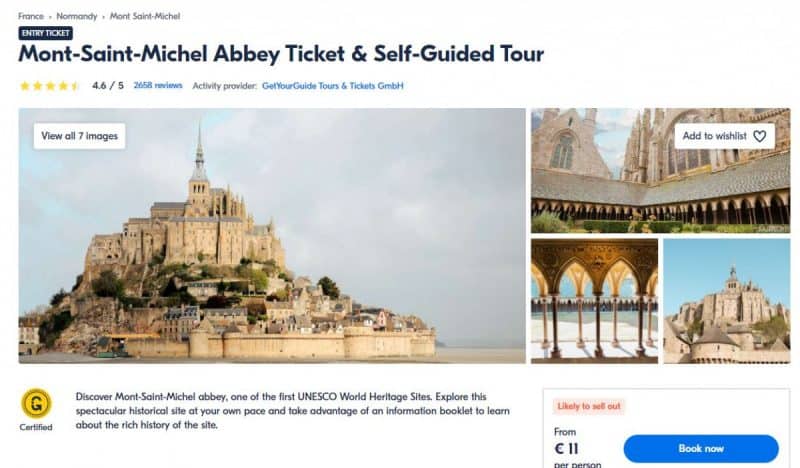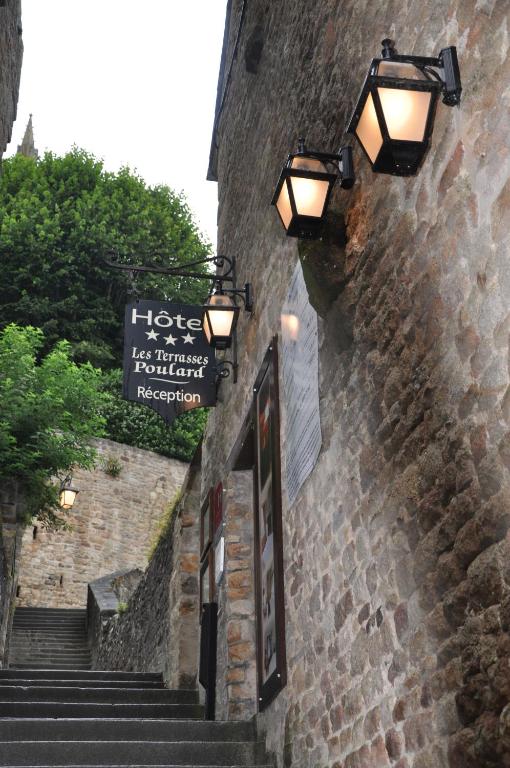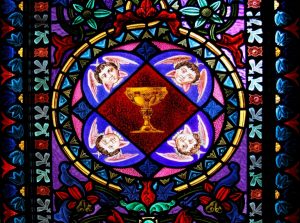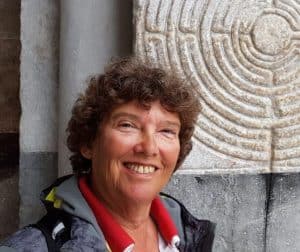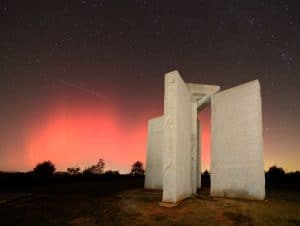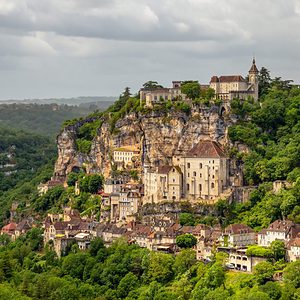A visit to Mont Saint-Michel is free. Cars are prohibited. There is a large car park with a shuttle connection. It is possible to spend the night on the island, but there are also plenty of hotels close to the dike.
You can view Mont Saint-Michel in one day, but I recommend experiencing the sunrise and sunset as well. The atmosphere in Mont-Saint-Michel is enigmatic. When I was there, I made two spiritual walks. If you are interested, you can download them here.
Within the download, I describe two spiritual walks. They are based on Patrick Burensteinas’s instructions. If you are interested in alchemy, you must see his DVD series “Le Voyage Alchimique.”
The English-subtitled DVDs describe the alchemical highlights of the pilgrimage to Santiago de Compostela. The series are available at Amazon.

The history of Mont Saint-Michel
In the flat, forested landscape just off the coast of Normandy stood two impressive hills. They were primarily composed of granite, and it appeared as if the massive stones had just fallen to the ground. It is a unique location.
The larger hill was known as Mont Tombe, while the smaller hill was known as Tomberlaine.
According to an old legend, the hills once covered the graves of giants or gods. The Celts had placed two upright stones at the base of the hill. With this, they indicated that the location was sacred.
The Dream of Saint Aubert
In 708 Saint Aubert, Bishop of Avranche, had a dream about the archangel Michael. The angel told him to construct a sanctuary on the larger of the two hills.
When the archangel drilled a hole in Aubert’s head with his finger on the third night, Aubert realized he needed to take the dream seriously.
From then on, the bishop’s sole mission was to transform Mont Tombe into Mont Saint Michel.
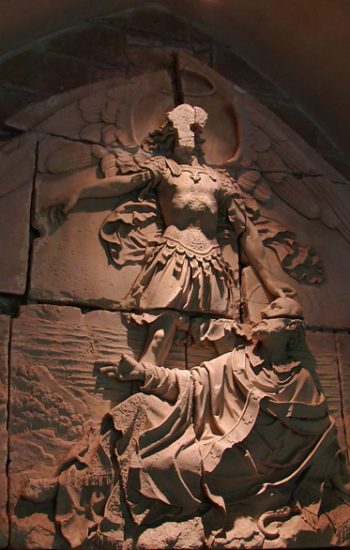
Saint Michael had previously made an appearance in Italy. After its appearance on Mount Gargano in the year 490, a sanctuary (Monte Sant’Angelo) was built there.
Saint Aubert sent French monks to Italy in order to gather relics of this apparition. They would return with a stone bearing the angel’s imprint and a piece of cloth.
How Mont-Saint-Michel was transformed into an island
The hills were still connected to the land at that time, but a year after Bishop Aubert’s dream, there was a big flood.
When the spring tide came in, it flooded the forest around the hills, and as the seawater rose, it left Mont Tombe and Tomberlaine in the sea. From then on, one could only visit the islands when the tide was low.
This certainly contributed to Mont-Saint-Michel’s unique appearance, so it is not surprising that it became a popular site.
The Normans
In the ninth century, the Normans came. These men from the north (Vikings) took possession of the mountain, and the monks flee. It was a turbulent time. With their fast ships and their enormous fighting spirit, the Vikings invaded parts of France.
They even managed to get to Paris following the Seine. In order to restore peace, part of France was assigned to the Normans in 911. That’s how Normandy got its name.
Rollo, the Norman chief, was Christianized in the town of Saint Clair-Sur-Epte. Therefore, Rollo decided to adopt the name of Saint-Clair. The Sinclair family eventually ended up in England. Through connections with Margaret of Scotland, the family came into possession of Roslin and were the founders of Rosslyn Chapel.
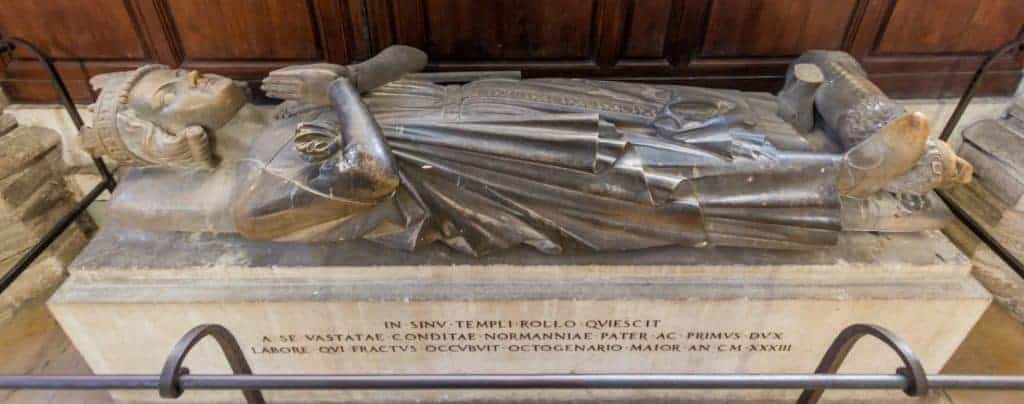
Decadent clergymen
The monks of Mont-Saint-Michel returned. And with them the pilgrims.
Pilgrims from England on their way to Santiago de Compostela, Rome or Jerusalem often visited Mont-Saint-Michel.
There was also a route connecting Mont St. Michel and Monte Sant’Angelo in Italy. The Camino dell’Angelo (the Angel’s Way) partly followed the Via Francigena, the ancient pilgrimage route that runs from Canterbury to Rome.
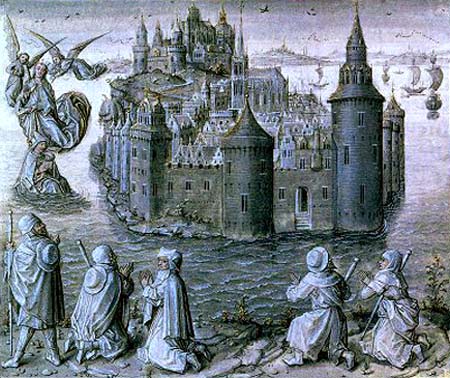
Despite their vows of obedience, poverty, and purity, the priests become richer and richer thanks to the money brought in by the pilgrims. The attraction of money was strong, and many clergymen married and had children. They lived a lavish and decadent lifestyle. This was a bone of contention for Richard I, son of Rollo and Duke of Normandy. A Benedictine monk was appointed to restore order in 966.
Father Maynard
Father Maynard was the first abbot of Mont Saint-Michel. Personal poverty, chastity, and obedience to the abbot were of the utmost importance to him. Priests must provide for themselves while praying the rest of the time. Of course, this was a good reason for all the decadent clergymen to leave.
The ascetic way of life, however, attracted new priests. They constructed a monastery on the hill, as well as a new abbey church.
The Normans lived at the foot of the hill running the hotels for pilgrims.
At the end of the 10th century, the monastery was destroyed by fire. A new church was constructed, but it was a tense time because Mont Saint-Michel is strategically located between England and France and was alternately occupied by both nations.
Robert de Torigni
In 1154, when Mont Saint-Michel was a part of England, Robert de Torigni was elected abbot. Various writers claim that this abbot had a keen interest in alchemy. In the archives of Avranches, several books supporting this claim have been found.
In his time, the monastery prospered, due to Torigni’s noble birth and great political influence. Among other things, he founded a school where novices are trained in music and poetry, among other disciplines.
After his death, unrest flares up once more. Normandy is reclaimed by France, but the Mont Saint-Michel clergy continues to support the English. As a result, the island is the scene of intense combat. The French would ultimately triumph.
The Marvel of Mont Saint-Michel
In 1203, a fierce fire destroyed the abbey. The French king, Fillips II, gave a large sum of money to the monks for the reconstruction. This money was used to finance a new abbey; a Gothic abbey was built on top of the Roman church. The three floors of this architectural masterpiece, called the “Marvel of Mont Saint-Michel (Merveille),” are held up by pillars and vaults.
The lower floor is intended for the poor pilgrims, the middle part for the nobility, and the upper part is dedicated to God and intended for the clergy.
Mont Saint-Michel and the Hundred Years' War
In 1337, France was again at war with the English. This war would last a hundred years. Mont-Saint-Michel was again besieged by the English, but this time the monks remain loyal to France. The siege ended in 1434. Two cannons were captured and can still be seen as trophies of this victory.
Bastille at sea
In 1793, Mont Saint-Michel became a prison for the opponents of the French Revolution. This counterpart of the Bastille in Paris was called the Bastille at sea. More than 14,000 people were held as political prisoners, often in terrible conditions. The cells regularly run underwater. When the French writer Victor Hugo visited the island in 1836, he was stunned that the abbey had become a sinister prison: ‘A drama full of dungeons, towers, and rocks’, he writes.
Contemporary restorations
The Bishop of Coutances rented the structures in 1865 with the intention of preserving the island’s religious roots. Ten years later, it is classified as a Monument Historique, and the renowned architect Viollet-le-Duc oversees a thorough restoration. The restoration was finished in his fashion after he passed away in 1879. Emanuel Frémiet, a sculptor, created the statue of the archangel Michael that decorates the top of the new tower in 1895.
Symbolism of Saint Michael

The archangel Michael overcomes the dragon. The dragon represents the devil, earth’s fire, and an unfulfillable desire.
The heavenly fire, or light, stands in opposition to the destructive and earthly fire. The sword in the angel’s hand represents this. Michael battles the dragon with this sword until it submits. Instead of being killed, the dragon yields to the light.
What to See and Do in Mont-Saint-Michel
If you would like an in-depth experience, I would advise you to download the alchemical walks below. They form an original guide of the Mont-Saint-Michel and you will see and experience things that “normal” tourists miss. If you don’t have the time for these walks, here are the highlights:
1. The three gateways
La Porte du Roy, Porte du Boulevard and Porte de l’Avancee are the 3 gateways you will see. Porte de l’Avancee is a stone-brick door, Porte du Boulevard is a beautiful arch, and La Porte du Roy is a beautiful arch-tunnel with a drawbridge.
2. La Grande Rue
The main street of Mont-Saint-Michel is more reminiscent of a fantasy than a French city, as it is lined with quaint boutiques and charming cafés. It can be highly crowded with tourists, but it is breathtakingly gorgeous at night or during the off-season.
3. Eglise Paroissiale Saint-Pierre
This modest, charming church located halfway up to the abbey is a perfect place to take a break from the crowds. It is a spot to contemplate for a few moments, as it is more tranquil than its surroundings.
Opening Hours: 9am-7pm daily
4. Abbaye du Mont-Saint-Michel
This is the main attraction at Mont-Saint-Michel. It is a great place to visit. From the courtyards to the grand halls to the corridors. The Abbaye du Mont-Saint-Michel is best seen in all its splendor after sunset during the special “sons et lumières” shows.
Opening Hours: July-August 9am-7pm daily
March and October 9:30am-12:30pm / 2pm-6pm daily
Easter-June & September 9am-12:30pm / 2pm-6pm
November-February 10am-12:30pm / 2pm-6pm
My advice is to book a Ticket and a Self Guided Audio Tour in advance. You’ll be able to skip the line.
5. La Chapelle-Saint-Aubert
This Chapel is even more quiet and concealed. Even if there is someone else in the chapel with you, the ambiance is peaceful and pleasant due to the chapel’s small size and paintings.
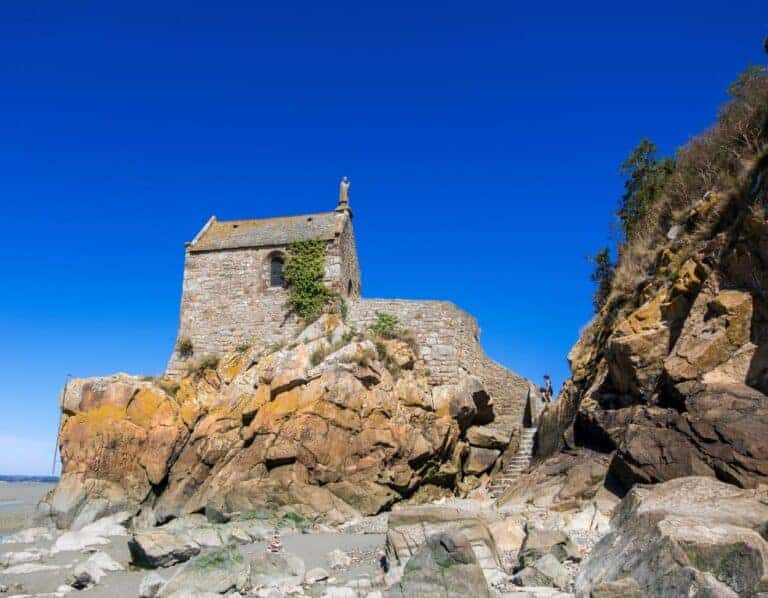
6. Spring tide
Manche’s spring tides are a wonderful sight on full and new moons throughout the year. The 360 kilometres of Manche’s coastline is constantly changing due to the tides. For a few hours the island of Mont-Saint-Michel returns to its natural state. For an actual table: https://www.manche-tourism.com/flow-sea.
7. Walking across the bay
You can enjoy a guided walk across the bay of Mont Saint-Michel. Accompanied by a licensed guide, you will walk along Tombelaine, cross rivers and conquer the quicksand until you reach Mont Saint-Michel. Don’t do this own your own! Here is a list of certified guides.
Best Time to visit Mont Saint-Michel
It is important to realize Mont Saint-Michel is visited by many people. If you really want to experience the magic of the place, it is best to do this early in the morning or after six o’clock in the evening.
Places to stay
Consider arranging an overnight stay in the village or booking a room in the hotel zone. If you use the map below, zoom in and out to see where the hotels are available.
Check if Les Terrasses Poulard is available. It might not be the best hotel, but it is authentic, and you will love to sleep in the village. It is a unique experience!
Parking
The car park is 2.5 km outside Mont Saint-Michel. With a shuttle bus (free) you will be transported to the entrance. The bus is prohibited for dogs. The first shuttle bus leaves at 07:30. If you want to walk, it will take you about 45 minutes.
Two Alchemical walks
Within the download, I describe two spiritual paths or alchemical walks. They are based on Patrick Burensteinas’s instructions. If you are interested in alchemy, you must see his DVD series “Le Voyage Alchimique.”
The English-subtitled DVDs describe the alchemical highlights of the pilgrimage to Santiago de Compostela. The series are available at Amazon.



